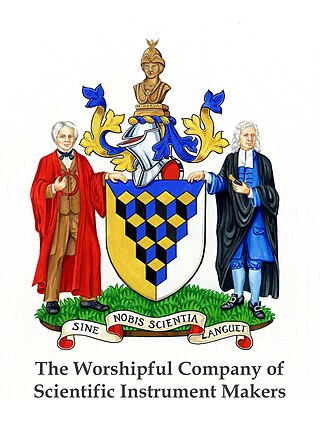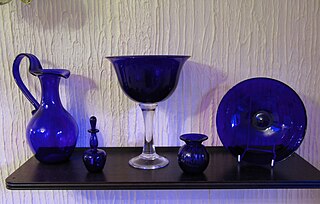
Bellaire is a village in Belmont County, Ohio, United States, along the Ohio River. The population was 3,870 at the 2020 census, having peaked in 1920. It is part of the Wheeling metropolitan area.

Dresden is a village in Muskingum County, Ohio, United States, along the Muskingum River at the mouth of Wakatomika Creek. The population was 1,650 at the 2020 census. It is part of the Zanesville micropolitan area. It was incorporated on March 9, 1835.

Zanesville is a city in and the county seat of Muskingum County, Ohio, United States. Located at the confluence of the Licking and Muskingum rivers, the city is approximately 52 miles (84 km) east of Columbus and had a population of 24,765 as of the 2020 census, down from 25,487 as of the 2010 census. Historically the state capital of Ohio from 1810 to 1812, Zanesville anchors the Zanesville micropolitan area and is part of the greater Columbus-Marion-Zanesville combined statistical area.

The Worshipful Company of Scientific Instrument Makers is one of the 111 livery companies of the City of London. It ranks 84th in the order of precedence for the livery companies.

Ebenezer Zane was an American pioneer, soldier, politician, road builder and land speculator. Born in the Colony of Virginia, Zane established a settlement near Fort Henry which became Wheeling, on the Ohio River. He also blazed an early road through the Ohio Country to Limestone known as Zane's Trace.

Hugh Judge Jewett was an American railroader and politician. He served as the United States representative from Ohio's 12th congressional district in the 43rd United States Congress.

The Hazel-Atlas Glass Company was a large producer of machine-molded glass containers headquartered in Wheeling, West Virginia. It was founded in 1902 in Washington, Pennsylvania, as the merger of four companies:
F&R Lazarus & Company was a regional department store with its retail chain operating primarily in the U.S. Midwest, and based in Columbus, Ohio. For over 150 years, Lazarus was influential in the American retail industry, particularly during the early 20th century as a founding partner in Federated Department Stores, and continued until the nameplate was retired on March 6, 2005, in favor of Macy's.

The Youngstown Ohio Works baseball team was a minor league club that was known for winning the premier championship of the Ohio–Pennsylvania League in 1905, and for launching the professional career of pitcher Roy Castleton a year later. A training ground for several players and officials who later established careers in Major League Baseball, the team proved a formidable regional competitor and also won the 1906 league championship.
Isaac Van Horne was a member of the U.S. House of Representatives from Pennsylvania.
John E. Hamm, M.D. was an American US Army colonel, doctor and politician, diplomat, industrialist, and Marshall of the State of Ohio during the War of 1812.

Bristol blue glass has been made in Bristol, England, since the 18th century, with a break between the 1920s and 1980s.

The Fenton Art Glass Company is a glass manufacturer founded in 1905 by brothers Frank L. Fenton and John W. Fenton.
Belmont Glass Company, also known as the Belmont Glass Works, was one of Ohio's early glassmaking companies. It was named after Belmont County, Ohio, where the plant was located. The firm began operations in 1866 in a riverfront village along the east side of the county, which is known as Bellaire. At that time, the community had resource advantages that made it an attractive site for glassmaking. Bellaire's location at the intersection of the Ohio River, the National Road, and two railroads meant it had an excellent transportation infrastructure. Fuel necessary for the glassmaking process was also readily available, since Belmont County was part of the eastern Ohio coal region. Bellaire also had a workforce with glassmaking expertise located less than five miles away, since glass had been produced in Wheeling, West Virginia, since the 1820s.

John McIntire was the founder of the city of Zanesville, Ohio.

Henry Crimmel was an American glassmaker who became well known in Ohio and Indiana. A German that came with his family to America at the age of eight years, the American Civil War veteran started at the lowest level in glass making, and learned every aspect of the business. A skilled glassblower known for his glassmaking expertise and the recipient of two patents, he also worked in management in at least three glass factories – and was one of the co-founders of the Novelty Glass Company and the reorganized version of Sneath Glass Company. He retired with over 50 years in the industry.
Libbey, Inc., is a glass production company headquartered in Toledo, Ohio. It was originally founded in 1818 in Cambridge, Massachusetts, as the New England Glass Company, before relocating to Ohio in 1888 and renaming to Libbey Glass Co. After it was purchased in 1935, it operated as part of the Libbey-Owens-Ford company and as a division of the Owens-Illinois glass company until 1993, when it was separated back into an independent company.
The A.J. Canfield Company was a Chicago-based independent producer of carbonated beverages founded in 1924. The company was known during its later years for marketing unusual flavors, including Canfield's Diet Chocolate Fudge; it was sold by the Canfield family in 1995 to Select Beverages.
J. H. Hobbs, Brockunier and Company was one of the largest and best-known manufacturers of glass in the United States during the 19th century. Its products were distributed worldwide. The company is responsible for one of the greatest innovations in American glassmaking—an improved formula for lime glass that enabled American glass manufacturers to produce high-quality glass at a lower cost. The firm also developed talented glassmakers that started glass factories in Ohio and Indiana.
The Glass Bottle Blowers' Association (GBBA) was a labor union representing workers involved in making blown glass in the United States and Canada.